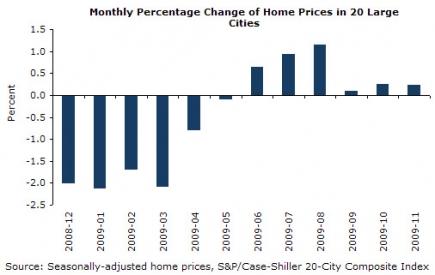January 27, 2010
January 27, 2010 (Housing Market Monitor)
By Dean Baker
Mortgage applications are running below the depressed levels of 2009.
Note: Beginning today, CEPR’s Housing Market Monitor will be published on a monthly basis, typically coming out on the last Wednesday of the month.
The Mortgage Bankers Association’s purchase mortgage applications index fell by another 3.3 percent last week and continues to run substantially below the depressed levels of January 2009. This indicates that housing purchases still are not recovering from the slump that followed in the wake of the original November 30th ending date for the first-time buyers tax credit. It seems virtually certain that prices will soon begin to decline again as the market will finish shedding the 15-20 percent of house price valuation that is attributable to the bubble.
The Case-Shiller index for November shows that the sharp increases of the late summer and fall are over. The 20-city index showed a 0.2 percent increase in November. Prices in 6 of the 20 cities are once again declining. Prices in Tampa fell by 0.5 percent in November and have fallen at a 10.6 percent annual rate over the last three months. In Chicago, prices dropped by 0.8 percent in November and were falling at a 2.1 percent annual rate in the last three months. In New York, prices dropped 0.9 percent in November and have fallen at a 5.4 annual rate over the last three months.

It is important to recognize that the monthly data in the Case-Shiller index is actually a three-month average. This allows for a larger sample and reduces the amount of erratic movement in the index. However it also can mask turning points. The November data is an average of prices for the months from October through December, two months when the tax credit was still a major motivator for buyers and one month after the original expiration date. Even if prices had started to drop in December, the fact that they had been rising in October and November is still likely to create a situation in which the index number for the month shows an increase relative to the October index number. In other words, the November index number is consistent with a situation in which prices are already declining in the 20 cities in the index.
The tiered index provides evidence that is consistent with the first-time buyers credit being a major factor in the recent price increases. In most cities, prices for houses in the bottom third of the market rose much more rapidly than the price of houses in the middle and top third. For example, in San Diego, prices for houses in the bottom tier rose at a 26.9 percent annual rate over the last quarter, while prices for houses in the top tier rose at just a 4.0 percent rate. In Tampa, prices for homes in the bottom tier rose at a 15.8 percent annual rate over the last three months, while prices for homes in the top tier fell at a 12.1 percent rate. In Minneapolis, prices for homes in the bottom tier rose at a 45.9 percent annual rate over the last three months, while prices for homes in the top tier rose at just a 0.1 percent rate.
The first-time buyers tax credit would be expected to have the most impact on the prices of less expensive houses both because first-time buyers are most likely to be purchasing less expensive homes and also because the credit is a larger percentage of the price of lower-priced homes. With the credit having been extended to the end of April (based on contract signing), it is likely that there will again be some uptick in demand soon, as homebuyers try to get in ahead of the expiration date.
In addition to the end of the credit, the lower end of the market will also be hit by the tightening of standards by the Federal Housing Administration (FHA). The FHA guaranteed close to 30 percent of purchase mortgages in 2009, essentially filling the gap created by the collapse of the subprime market. As a result of its shortfall, it will be playing a smaller role in the market in 2010. It is likely that the December index will show that prices have resumed their decline.
Dean Baker is Co-Director of the Center for Economic and Policy Research, in Washington, D.C. CEPR’s Housing Market Monitor is published monthly and provides an incisive breakdown of the latest indicators and developments in the housing sector.






